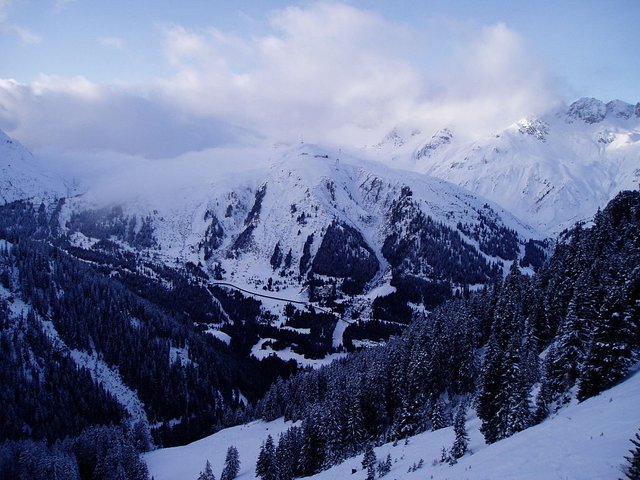
For many skiers, when springs makes its appearance in early March, its time to put away their skis and bid a wistful goodbye to the winter. The once-crowded slopes become deserted as the sun begins to shine hotter and longer each day, the après-ski bars quiet down, and the resorts empty out and close for the summer. Only a few of the luckier, more ardent or more knowledgeable skiers are left to take advantage of one of the most enjoyable periods of the skiing calendar: the spring.
What’s so great about spring skiing
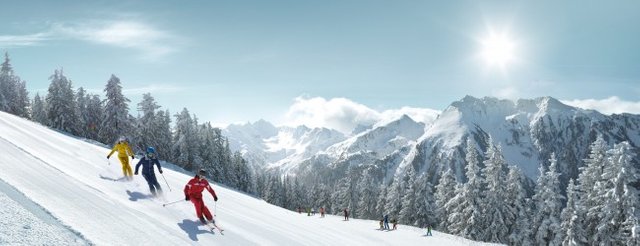
Spring skiing has many perks not enjoyed by those skiing in deep winter, but the glaringly obvious one is: fewer people. By the time February rolls around, the slopes are emptying, many of the resorts are closing and the few which do stay open are offering bargain rates to attract the last-minute holidaymakers. Less competition on the slopes and low prices? For spring skiers, it’s almost unthinkable not to take up advantage of such an attractive offer!
Spring skiing also offers a far different experience from its deep winter equivalent. For one thing, the snow itself is different. Over the months, the snow has accumulated, pressed firmly down, stabilized. Instead of the thick powder snow of winter, spring skiers are treated to slopes decked in corn snow, a large grained layer of fresh snow over hard-packed, icy slopes. Whether it’s more fun to snow on powder or corn snow is mostly matter of personal opinion, but there are many who vow that corn snow skiing is one of those ‘must-ski’ experiences every halfway decent skier should have at least once in their lifetimes.Another advantage of late season skiing is that for every lower-altitude ski field being turned into slush with the advent of spring, there is another, higher-altitude ski destination just coming into its prime. The fresh, white thickness of late spring snow transforms valleys and peaks which were previously inaccessible earlier in the winter into tantalizing, virgin slopes for the exploration of the intrepid late-season adventurer.Skiing the higher snow fields and glaciers offers conditions much like those in deepest winter.Unfortunately, this also includes the occasional blizzard when Old Man Winter decides to pay a return visit. Still, for those with a good weather sense and an adventurous spirit, or at least a decent ski guide, keeping a sharp eye on the weather is a small price to pay for some of the most exquisite skiing of the season.
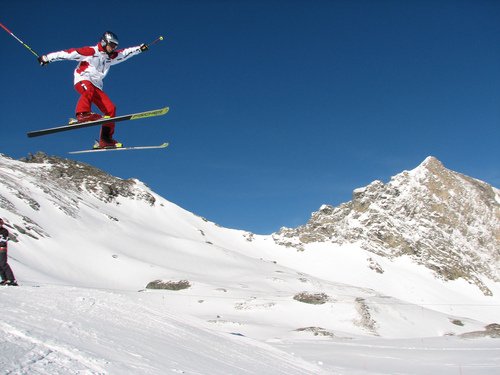
By about 3 in the afternoon, its time to head off the slopes, as the sun gets too enthusiastic and starts turns the slopes in big puddles of mush. At this point, the true magic of spring time skiing becomes apparent — when you step off the snow fields of the higher mountains and head for lower altitudes, you can leave winter completely behind you and descend into a valley where spring flowers are blooming in the meadows, birds are busy building their nests and everyone is walking around in shorts and t-shirts.
Speaking of shorts and t-shirts, another really great point about spring skiing is that you can wear just such skimpy attire on the slopes. As the sun blazes down on the slopes, many spring skiers doff their three layers of winter gear and swoop down the slopes in just a sweater or t-shirt — or for the more brazenly daring, not even that. Once you’ve enjoyed the freedom of skiing while wearing nothing much, you may never again want to wear a parka while you’re skiing!
Tweets about Austrian Alps
About Austrian Alps on Twitter
Where to go for spring skiing in Austria
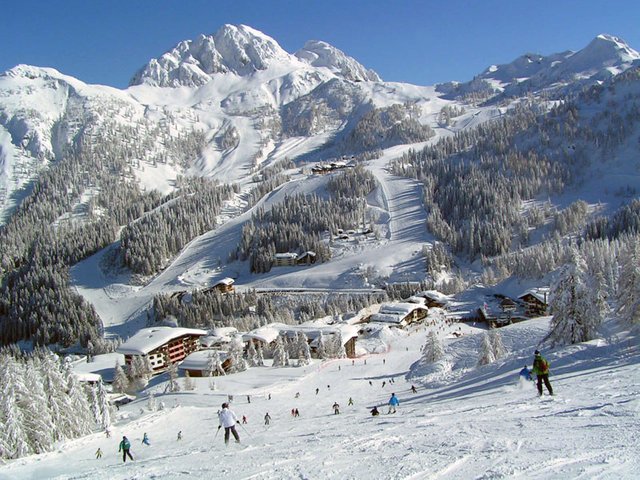
There are plenty of places to ski in Austria. Much like Switzerland, the country is a veritable winter wonderland, with a generous scattering of excellent resorts sprinkled over the three major mountain chains — the Northern Limestone Alps, the High Alps and the Southern Limestone Alps. The mountain elevation in Austria is generally lower than in Switzerland, the resorts still receive abundant snowfalls as the winters tend to be colder, particularly in the east.
All these resorts offer great skiing during the early spring months, but as March turns to April and then to May, many of the lower-altitude resorts give up fighting against the encroaching warmth and close. To continue skiing, you need to move higher up the mountains. The further up you go, the longer the ski resorts stay open and some penultimate resorts, situated near ski fields too high up to ever thaw, stay open all year round.For those who love partying as much as skiing, the Saalbach-Hinterglemm resort is the best place to go. Located in the Glemmtal Valley about 90 km away from Salzburg, this ski resort is the second most popular destination in Austria, after Vienna and is particularly popular with Dutch and German vacationers. Of the two villages which give the valley its name, Saalbach is the larger and more vibrant, but since both villages have grown until they almost form one village, the point is a bit moot.
Given its popularity, it’s no surprise to find that almost everything you need is on offer here, with an impressive nine ski schools to choose from, excellent restaurants, reasonably priced accommodations and some of the best guides in the country. The entire area, which includes slopes on both sides of the valley as well as several other mountain faces and wide-open bowls, is aptly called the Ski Circus. Most of the slopes are best suited for intermediate skiers, but both beginners and experts will find a satisfying run or three, and unless you have the endurance of Superman, it’s probably best to save your energy and stick to one area a day. Such restraint also means you’ll have enough energy after skiing to take part in the many drinking parties and après-ski activities which have made this particular resort so popular!
Probably the most popular glacier in the country is the Hintertux. The glacier is located in the newly created ski area of the Ski & Glacier World Zillertal 3000, a lift system which connects lower- and higher-altitude hamlets, to produce the largest network in the Ziller valley, and one which offers guaranteed year round skiing. With 11 interconnected areas offering every possible snow experience, a free bus network, plenty of accommodations to suit every taste and facilities for every need, this is the most comprehensive ski areas to go to for some late season skiing.For more year round skiing, another popular glacier resort to head for is Zell am See, located in central Austria about 80 km from Salzburg. This car-free town next to Lake Zee has a bus link to the neighbouring Kaprun glacier, which runs about once an hour during the spring. From Kaprun, you can take a cable car to the top of Kitzsteinhorn glacier, where you can get spectacular views of the Grossglockner, Austria’s highest peak. If glacier skiing isn’t your cup of tea, there’s also 80 km worth of trails winding around the Schmittenhoe mountain behind the town, which is sometimes ski-able even late in the season, if the conditions are right. Thanks to its unique positioning, the resort offers guests the chance to go skiing in the morning, then swimming in summer-warm lake waters in the evening.
Two other ski resorts popular for spring skiing are Obergurgl/Hochgurgl and Sölden. The two villages of Obergugl and Hochgurgl are located in the Otztal Valley near the south Tirol border. Obergugl is the most famous of the village cluster, not only for its standing in Austrian ski history, but also because it is one of the prettiest and highest of the Austrian resorts, sitting pretty at about 6000 feet. Hochgurgl is a little lower down at 7050 feet, together with the lesser known sister of these two villages, Untergurgl. Nightlife and restaurants are more varied in Obergurgl, while Hochgurgl offers the most luxurious accommodations. The high altitude, and a little judicious snow-making, means the resort offers excellent skiing all the way until the end of May. Nearby Solden is more resort than village, with huge chalet style hotels, swimming pools and a notoriously boisterous nightlife, but in recent years it seems to have calmed down a bit, and has the bonus of offering two glaciers for the price of one. There are also plenty of marked trails for a little variety.
Some cautions before you go spring skiing
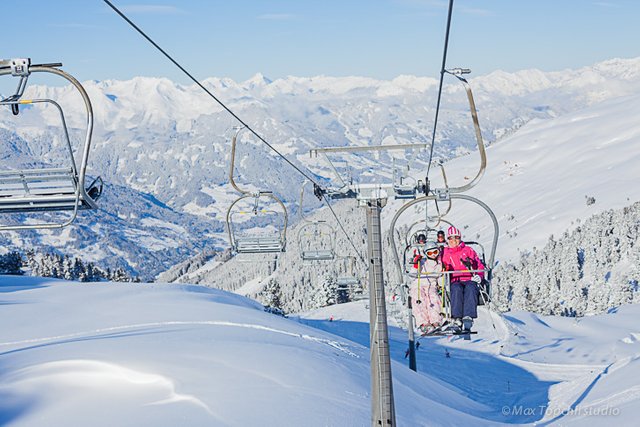
Spring skiing is a wonderful experience, but there are a few things you have to consider before planning a ski trip that late in the season. The most obvious is to keep a lookout on snow cover and the weather. Aiming for the higher resorts is a good way to hedge your bets, but you’ll still need to be flexible and watch out for cold snaps or unseasonably hot weather, which may alter your plans drastically. Fortunately, no ski resort of any repute would go without issuing a snow and weather report, so this is a fairly easy factor to take into consideration.
One Austrian weather phenomenon which might put a hole in even the best laid plans is the foehn. This very warm, dry, wind sweeps over the country from the hotter climes of the south and occurs most often during autumn and spring, when it can melt the snow with heartbreaking speed. Alpine valleys which run south and north are particularly susceptible. The foehn is sometimes blamed for setting up the right conditions for avalanches, and for making the air so dry it poses a serious fire risk to the ubiquitous wooden chalets.Apart from such cautions however, a spring skiing trip isn’t any more troublesome or difficult to arrange than the more usual winter skiing trip. Time the trip right, and with the sharp drop in prices, the greater freedom on the slopes, the fantastic snow conditions and the chance to go beach sunbathing after a hard morning’s skiing, there’ll be no better way to make the most of your spring!
Hi! I am a robot. I just upvoted you! I found similar content that readers might be interested in:
http://www.travellercc.com/springtime-skiing-austrian-alps/
Downvoting a post can decrease pending rewards and make it less visible. Common reasons:
Submit
Congratulations @ercu145! You have completed some achievement on Steemit and have been rewarded with new badge(s) :
Click on any badge to view your own Board of Honor on SteemitBoard.
For more information about SteemitBoard, click here
If you no longer want to receive notifications, reply to this comment with the word
STOPDownvoting a post can decrease pending rewards and make it less visible. Common reasons:
Submit